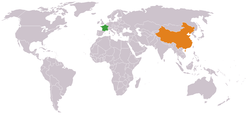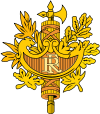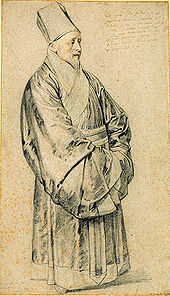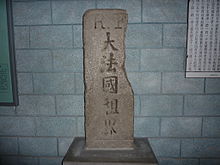- China–France relations
-
Sino-French relations 

France
ChinaChina–France relations Chinese name Traditional Chinese 中法關係 Simplified Chinese 中法关系 Transcriptions Mandarin - Hanyu Pinyin Zhōng-Fǎ guānxì French name French Relations franco-chinoises China-France relations, also known as Sino-French relations or Franco-Chinese relations, refers to the interstate relations between China and France (Kingdom or later).
Note that the meaning of both "China" and "France" as entities has changed throughout history; this article will discuss what was commonly considered 'France' and 'China' at the time of the relationships in question. There have been many political, cultural and economic relationships between China and France.
Contents
History
17th and 18th centuries
Numerous French Jesuits were active in China during the 17th and 18th century: Nicolas Trigault (1577-1629), Alexander de Rhodes (1591-1660, active in Vietnam), Jean-Baptiste Régis (1663-1738), Jean Denis Attiret (1702-1768), Michel Benoist (1715-1774), Joseph-Marie Amiot (1718-1793).
French Jesuits pressured the French king to send them to China with the aims of counterbalancing the influence of Ottoman Empire in Europe. The Jesuits sent by Louis XIV were: Jean de Fontaney (1643-1710), Joachim Bouvet (1656-1730), Jean-François Gerbillon (1654-1707), Louis Le Comte (1655-1728) and Claude de Visdelou (1656-1737).[1] Returning to France, they noticed the similarity between Louis XIV of France and the Emperor Kangxi. Both were said to be the God servitor, and to control their respective area: France being the strongest country of Europe, and China being the strongest power in East Asia. Other biographical factors lead commentators to proclaim that Louis XIV and Kangxi were protected by the same Angel. (In childhood, they overcame the same illness; both reigned for a long time, with many conquests.)
Under Louis XIV's reign, the work of these French researchers sent by the King had a notable influence on Chinese sciences, but continued to be mere intellectual games, and not tools to improve the power of man on nature. Conversely, China was fashionable in France, examplified by the Chinoiserie fashion, and Louis XIV had the Trianon de Porcelaine built in Chinese style in 1670.
In the same time, the first ever known Chinese people came to the French Kingdom. Michel Sin went to Versaille in 1684 before continuing to England. More notable is Arcadio Huang, who crossed the Kingdom in 1702, spent some time in Rome (for the Rites dispute), and came back to Paris in 1704, where he was the "Chinese interprete of the King", and died in 1716. He started the first ever Chinese-French dictionary, and a Chinese grammar to help French and European researchers to understand and study Chinese, but died before finishing his work.
In the 18th century, the French Jesuit Michel Benoist, together with Giuseppe Castiglione, helped the Qianlong Emperor build a European-style area in Old Summer Palace (often associated with the European-style palaces (Xi Yang Lou) built of stone), to satisfy his taste for exotic buildings and objects. Jean Denis Attiret became "Painter to the Emperor" Qianlong. Joseph-Marie Amiot (1718-1793) also won the confidence of the Qianlong Emperor and spent the remainder of his life at Beijing. He was official translator of Western languages for Emperor Qianlong, and the spiritual leader of the French mission in Peking.[2]
19th century
From the (if rather distant) cordiallity of the ancien régime, Sino-French relations would deteriorate in European rush for colonies, even as they matured. Nineteenth century Europe was eager for the acquisition of colonies, and as European opinion of China deterorated, the once admired empire would become the subject of unequal treaties and colonisation. In 1844, China and France concluded its first modern treaty, the Treaty of Whampoa, which demanded for France the same privileges extended to Britain. In 1860, the Summer Palace was ransacked by French units. Many precious objects nowaday in French museums come from this looting. Later, France would seize Guangzhouwan as a treaty port, and take its own concession in the treaty port of Shanghai.
- French Indochina era
- Second Opium War,
- Sino-French War, and French Indochina,
- Eight-Nation Alliance
- French post offices in China
- Yunnan–Vietnam Railway
Post World War II
France and the PRC had established ambassadorial level diplomatic relations by 1964, before West Germany did so with China. This was precipitated by Charles de Gaulle's official recognition of the People's Republic of China. Deng Xiaoping completed his studies in Paris prior to ascending to power in China.
Post-Cold War
This state of relations would not last, however. During the 1990s, France and the PRC repeatedly clashed as a result of the PRC's One China Policy. France sold weapons to Taiwan, angering the Beijing government. This resulted in the temporary closure of the French Consulate-General in Guangzhou. France eventually agreed to prohibit local companies from selling arms to Taiwan, and diplomatic relations resumed in 1994.
Since then, the two countries have exchanged a number of state visits. Today, Sino-French relations are primarily economic. Bilateral trade reached new high levels in 2000. Cultural ties between the two countries are less well represented, though France is making an effort to improve this disparity.[citation needed]
2008 rifts
In 2008, Sino-French relations took a downturn in the wake of the 2008 Summer Olympics torch relay. As torchbearers passed through Paris, activists claiming allegiance to Tibetan independence and human rights repeatedly attempted to disrupt, hinder or halt the procession.[3] The Chinese government hinted that Sino-French friendship could be affected.[4] Chinese protesters organized boycotts of the French-owned retail chain Carrefour in major Chinese cities including Kunming, Hefei and Wuhan,[5] and hundreds of people joined anti-French rallies in those cities and Beijing.[6] Both governments attempted to calm relations after the demonstrations. French President Nicolas Sarkozy wrote a letter of support and sympathy to Jin Jing, a Chinese athlete who had carried the Olympic torch.[7] Chinese President Hu Jintao sent a special envoy to France to help strengthen relations.[8]
However, relations again soured after President Sarkozy met the Dalai Lama in Poland. Chinese Prime Minister Wen Jiabao omitted France in his tour of Europe in response, his assistant foreign minister saying of the rift "The one who tied the knot should be the one who unties it."[9] French Prime Minister Jean-Pierre Raffarin was quoted in Le Monde as saying that France had no intention of "encourag[ing] Tibetan separatism".[10]
Notes
- ^ Eastern Magnificence and European Ingenuity: Clocks of Late Imperial China - Page 182 by Catherine Pagani (2001) [1]
- ^ Alain Peyrefitte, "Images de l'Empire Immobile", p.113
- ^ "China condemns Olympic torch disruptions", France 24, April 8, 2008
- ^ "Raidissement des relations sino-françaises", Radio France Internationale, April 15, 2008
- ^ "National flag of France with Hakenkreuz added by Chinese protesters" (in French). Reuters. 2008-04-19. http://www.reuters.com/news/pictures/searchpopup?picId=3943345. Retrieved 2008-04-19.
- ^ "Anti-French rallies across China", BBC, April 19, 2008
- ^ "«Chère mademoiselle Jin Jing, je voudrais vous dire toute mon émotion...»", Libération, April 28, 2008
- ^ "La porte-parole du ministère des AE appelle aux efforts conjoints de la Chine et de la France pour promouvoir les relations bilatérales", The People's Daily, April 23, 2008
- ^ "China ready to mend ties if France moves first", AFP, january 22, 2009
- ^ "'Encore du travail' pour des retrouvailles entre Pékin et Paris (Raffarin)", Le Monde, February 10, 2009
References
The China Quarterly (2002), 169: 33-44 Cambridge University Press Copyright © The China Quarterly, 2002 doi:10.1017/S0009443902000049 Published online by Cambridge University Press 25Apr2002
See also
- Foreign relations of China
- China Policy Institute
- Foreign relations of imperial China
- Foreign relations of the Republic of China (from 1911...)
- Foreign relations of the People's Republic of China (after 1949)
- Foreign relations of the Republic of China (...to today)
- Anglo-Chinese relations
 Foreign relations of the People's Republic of China
Foreign relations of the People's Republic of ChinaAfrica Algeria · Angola · Benin · Botswana · Burkina Faso · Burundi · Cameroon · Cape Verde · Central African Republic · Chad · Comoros · Congo, Democratic Republic of the · Congo, Republic of the · Côte d'Ivoire · Djibouti · Egypt · Equatorial Guinea · Eritrea · Ethiopia · Gabon · Gambia · Ghana · Guinea · Guinea-Bissau · Kenya · Lesotho · Liberia · Libya · Madagascar · Malawi · Mali · Mauritania · Mauritius · Morocco · Mozambique · Namibia · Niger · Nigeria · Rwanda · São Tomé and Príncipe · Senegal · Seychelles · Sierra Leone · Somalia · South Africa · South Sudan · Sudan · Swaziland · Tanzania · Togo · Tunisia · Uganda · Zambia · Zimbabwe
Asia Afghanistan · Armenia · Azerbaijan · Bahrain · Bangladesh · Bhutan · Brunei · Burma · Cambodia · China, Republic of (Taiwan) · East Timor · Georgia · India · Indonesia · Iran · Iraq · Israel · Japan · Jordan · Kazakhstan · Korea, North · Korea, South · Kuwait · Kyrgyzstan · Laos · Lebanon · Malaysia · Maldives · Mongolia · Nepal · Oman · Pakistan · Palestine · Philippines · Qatar · Russia · Saudi Arabia · Singapore · Sri Lanka · Syria · Tajikistan · Thailand · Turkey · Turkmenistan · United Arab Emirates · Uzbekistan · Vietnam · YemenEurope Albania · Andorra · Austria · Belarus · Belgium · Bosnia and Herzegovina · Bulgaria · Croatia · Cyprus · Czech Republic · Denmark · Estonia · Finland · France · Germany · Greece · Hungary · Iceland · Ireland · Italy · Latvia · Lithuania · Luxembourg · Macedonia · Malta · Moldova · Monaco · Montenegro · Netherlands · Norway · Poland · Portugal · Romania · Russia · San Marino · Serbia · Slovakia · Slovenia · Spain · Sweden · Switzerland · Turkey · Ukraine · United Kingdom · Vatican CityNorth America Antigua and Barbuda · Bahamas · Barbados · Belize · Canada · Costa Rica · Cuba · Dominica · Dominican Republic · El Salvador · Grenada · Guatemala · Haiti · Honduras · Jamaica · Mexico · Nicaragua · Panama · Saint Kitts and Nevis · Saint Lucia · Saint Vincent and the Grenadines · Trinidad and Tobago · United StatesOceania Australia · Fiji · Kiribati · Marshall Islands · Micronesia · Nauru · New Zealand · Palau · Papua New Guinea · Samoa · Solomon Islands · Tonga · Tuvalu · VanuatuSouth America Argentina · Bolivia · Brazil · Chile · Colombia · Ecuador · Guyana · Paraguay · Peru · Suriname · Uruguay · VenezuelaMultilateral Diplomacy  Foreign relations of France
Foreign relations of FranceAfrica Algeria · Angola · Chad · Republic of the Congo · Djibouti · Egypt · Gabon · Libya · Mali · Mauritania · Morocco · Niger · Senegal · Tunisia
Americas Argentina · Barbados · Brazil · Canada · Colombia · Haiti · Texas (historical) · Trinidad and Tobago · United States · Uruguay · VenezuelaAsia Middle EastElsewhereChina · India · Japan · Malaysia · Myanmar · North Korea · Pakistan · South Korea · Thailand · VietnamEurope Andorra · Armenia · Austria · Azerbaijan · Belarus · Belgium · Bulgaria · Croatia · Cyprus · Czech Republic · Denmark · Estonia · Finland · Georgia · Germany · Greece · Holy See · Hungary · Iceland · Ireland · Italy · Kosovo · Latvia · Lithuania · Malta · Moldova · Monaco · Montenegro · Norway · Poland · Romania · Russia · Serbia · Slovakia · Slovenia · Spain · Switzerland · Turkey · Ukraine · United KingdomOceania Missions Ministry of Foreign Affairs · Diplomatic missions of / in France · France and the Commonwealth of Nations · Foreign alliances of France · France and the United NationsFrench Foreign Ministry Categories:- Bilateral relations of China
- Bilateral relations of France
Wikimedia Foundation. 2010.




